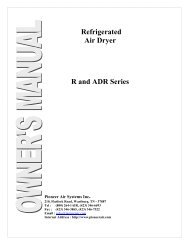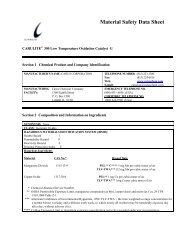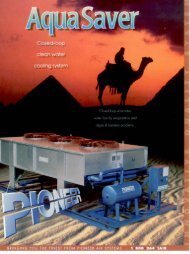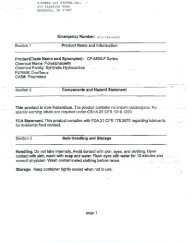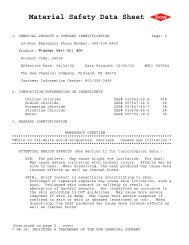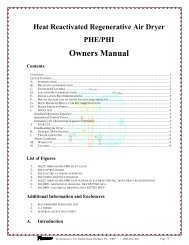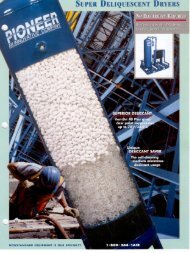XDT Manual - Pioneer Air Systems Engineering
XDT Manual - Pioneer Air Systems Engineering
XDT Manual - Pioneer Air Systems Engineering
Create successful ePaper yourself
Turn your PDF publications into a flip-book with our unique Google optimized e-Paper software.
<strong>XDT</strong> User’s <strong>Manual</strong>displaying the calculations and then will display END for a few seconds, after which the instrumentwill automatically go into measuring mode. The sensor calibration is completed. (Thedisplay may flash SAT, indicating that the sensor has super-saturated. As soon as the sensor isexposed to an atmosphere with a dewpoint lower than the saturation dewpoint, the display willindicate the dewpoint measured by the sensor.) The display may show alternating SEN and 2LOas an indication that the measured capacitance is too low to be from a saturated sensor, in thiscase make sure that the sensor is properly plugged in, and repeat the calibration procedure.7. Install the sensor in the sample cell or adapter fitting or put it back into the packaging containerfor later use.The instrument will retain the calibration even if the power is turned off.Under certain conditions, an over (super) saturated sensor may need to be completely dried outbefore a calibration is performed. Symptoms of these conditions are a sensor that will not gothrough the SpanCheck function to the END display, or a sensor that will not dry down after calibration.To dry, install sensor in either a known dry gas stream i.e. instrument quality air or drynitrogen, or place sensor in a dry can or bottle of desiccant and seal the container from outside air(the shipping container is designed for this purpose). After a minimum dry out period of 24 hours,proceed with the calibration procedure of your choice.SpanCheck calibrates sensors by using micro climates. Please contact your representative ifyou have any questions about how to create such micro climates.A perfectly acceptable and accurate for calibration micro-climate may be created for the XTR100and XTR65 sensors by cupping the sensor in the palm of one’s hand during the SpanCheck procedure.Remember that the micro-climate does not have to be accurate, it just has to be higherthan the designed saturation level. The dewpoint of the micro-climate within the fingers is usuallyhigher than the dewpoint of the room air and probably well above the +20°C upper range of thesensor. On a dry day, one may need to exhale in the hand before cupping the sensor to guarantee ahigh dewpoint. The sensor should be warmed up close to body temperature before performing thisprocedure. Care must be taken that the sensor temperature is not below the temperature of thehand, as in such case condensation could occur and super saturate the sensor. For the same reason,avoid exhaling directly onto the sensor.3.4.4.3.2 Single Point Self Calibration, manual or scheduledThe instrument is calibrated at the factory with the sensor it is shipped with and does not need tobe re-calibrated prior to installation.Single point calibrations should be performed whenever the measurement is in question, or on ascheduled basis depending on the application. Consult with your representative to establish criteriafor specific applications.The single point calibration is performed on the premise that the sensor is exposed to a gas with aknown dewpoint for a time sufficient to equilibrate. Then the sensor output is measured, and thecalibration curve is adjusted to provide measurement computations which correspond to theknown dewpoint. Measurements over the full sensor range are linearly adjusted to this knownpoint.The single point calibration provided by this instrument may be performed manually, or (when asample system is ordered equipped with an electrically actuated switchover valve) unattended on22



